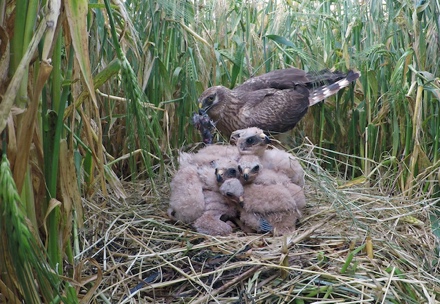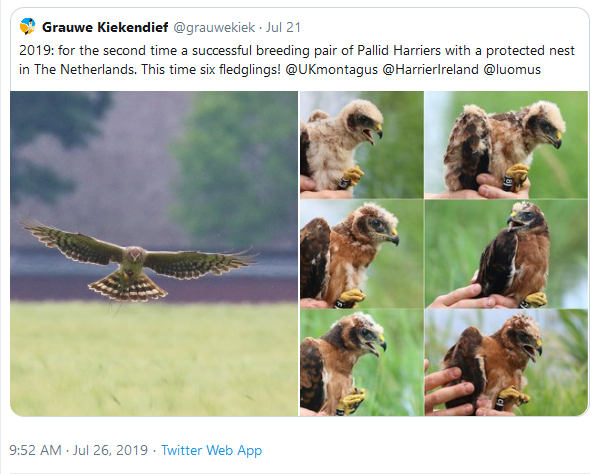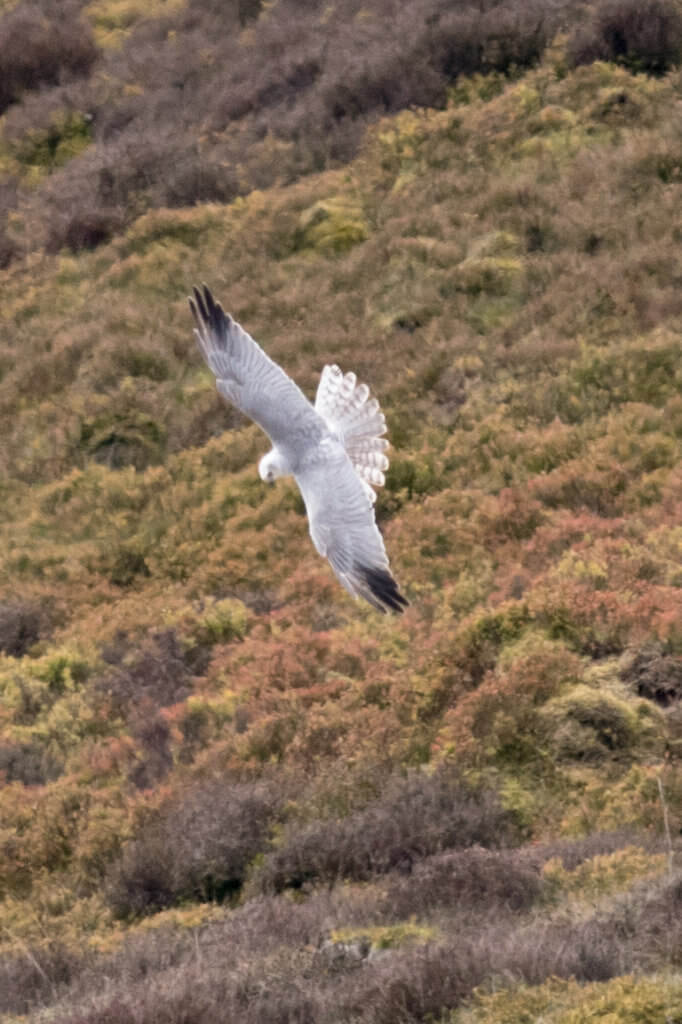
In 2017 the first pair of Pallid Harriers to nest in western Europe was reported from the Netherlands (see here). After no further nesting in the Netherlands in 2018 it might have seemed that this was a remarkable and amazing one-off event but the evidence is that Pallids are spreading west, not so slowly but very surely.
This year, Pallid Harriers have nested again in the Netherlands, in the same general area as in 2017. This seems not to be just a flash-in-the-plan.

But that 2017 Netherlands nesting produced a female bird which bred this year – in the first ever Pallid Harrier nest in Spain!
It’s notable that Pallid Harriers seem to be most commonly found nesting in cereal fields in places where this is also the habit of Montagu’s Harrier – but that may just be because people studying Montagu’s Harriers are in a good position to find Pallid Harriers whereas other Pallids go unnoticed.
In the UK our Montagu’s Harrier population is at a low ebb – and some have certainly been shot. North Norfolk doesn’t, I’m told, have nesting Montagu’s Harriers any more.
One wonders what the prospects are for nesting Pallids in the UK in the next few years. I guess it depends on many things, including whether any attempts at nesting are made in cereal fields, like Montagu’s Harriers often do, or on moorlands, like Hen Harriers tend to do. In the spring of 2017 when the Dutch were looking after their first pair of Pallid Harriers this male Pallid was seen for a while in the Forest of Bowland but, it didn’t stay on to breed.

Ben Koks, who studies Montagus Harriers in the Netherlands and is an enthusuiast for Pallids (but then, who isn’t?) reckons that Pallid Harriers will breed in the UK in the next two summers. In fact, he is so confident that he tells me he’ll buy me a good bottle of wine if they don’t. Sounds good, but I’ve told Ben that it would be such a great thing to have Pallids here in the UK that I’ll buy him a bottle of good wine if they do nest here in the next two years!
It seems likely that Ben and I will be testing some wines fairly soon as he will be at the Bird Fair the week after next.
Anyway, here again is that marvellous video of the Pallid Harriers from the Netherlands in 2017.
Until certain things change here the Pallid Harriers will be well advised to stay on the eastern side of the North Sea. I hope and trust those changes will eventually happen. It would be marvellous to have four species of harrier flying freely and without persecution in the British Isles.
There were actually two displaying male Pallid Harriers in 2017. the bird in Bowland and another on the North Yorkshire/Cumbria border in the Yorkshire Dales NP, both of course in areas at the time with Hen Harriers ( hence the justifiable lack of publicity concerning the Yorkshire bird). It has been suggested by some that the disappearance of the Bowland male just as most grouse chicks were hatching was a sinister coincidence but of course there is no evidence for that.
What is presumed to be one these males was also seen in southern Cumbria that autumn.
Having seen male Pallid Harrier in Bulgaria, what a marvellous bird.
That’s the great thing about birds they have wings and as long as they don’t mind crossing a stretch of water there’s nothing stopping them from giving old Blighty a go as a new home to raise chicks. It would be incredible to have four species of harriers breeding here. Even five years ago who would have thought that the pallid harrier was a likely colonist? Amazing. Derek Gow has mentioned that should there be habitat for them black storks could extend their breeding range to the UK as they are increasing in Belgium, and Roy Dennis has said they were a former resident species. Black and white storks breeding in southern England? Glossy ibis and penduline tit strong candidates for colonisation too. If efforts to create montane forest in Scotland are successful then perhaps Lapland bunting and bluethroat new breeders as well. Exciting stuff.
The two birds that used to breed here but no longer do are until recently rarely mentioned Dalmatian Pelican, which I suppose could be accommodated in our new and increasingly large wetlands. The other is Spotted Eagle, sadly we now longer have the wet woodland forest that this bird thrives in.
All of these possibilities including Lynx are infinitely more exciting in our until recently increasingly sanitised countryside. Although we still need to get a grip in preserving what we have got!
Thank you I hadn’t realised there was confirmation the spotted eagle had been a native, been surmised for long enough. I know they found ankle bones of the pygmy cormorant in one of the fens, I believe they’re not even on the British list as a one off vagrant now. In ‘Rebirding’ Ben MacDonald has a plan for bringing the Dalmatian pelican back to the Somerset levels which is great and makes me chuckle when I think of the aggro there already is from anglers about cormorants. I always wonder why the wolverine never hung on in Scotland at least, or did it and it was killed off by people we just haven’t found remains? A few years ago I used to help organise a small wildlife festival and I discovered there was no display available covering all the ‘main’ species lost to the UK via human agency – not just wolf, lynx and bear, but elk, gray whale, walrus, great auk, black tern, Sturgeon, burbot, aurochs, Dalmatian pelican and some impressive insects like the black veined white and large copper butterflies and the blue stag beetle. How many members of the general public would be amazed at the range of what we’ve lost? Shame such a display doesn’t exist.
That would be an interesting and useful display but I am not sure that the loss of all of those species can be unequivocally pinned on human agency can it Les? Walrus was surely due to climate change at the end of the ice age wasn’t it? and I am not sure the causes of the loss of some others is known e.g. Black-veined White, Blue Stag Beetle.
I believe there were walrus in northern Scotland at least to a few hundred years ago, like several ‘northern’ animals they may actually have a wider climatic tolerance than we think because they’ve been killed off in the southern parts of their range by human pressure. I’m sure I saw a walrus skeleton in Ipswich museum that was found in the fens in bronze age deposits. We used to think that leatherback turtles appearing in our seas were lost, now we know they come here deliberately to feed on jellyfish. So potentially we could have had one species assumed to be an arctic one mixing quite naturally with one assumed to be tropical in our seas, that’s an incredible thought. Yes in some cases might be a bit contentious to say human agency was responsible for loss, but usually very likely even with insects. I think we lost some biggish dead wood beetles almost certainly because of woodland fragmentation and ‘management’ that meant there was a dearth of Deadwood – I believe we had Cerambyx cerdo once upon a time, a cracking longhorn beetle. Yes it would be good if the public could see all the species (probably) lost through human agency from these isles in ‘a oner’. Think it would have an impact on people that we used to have something resembling a penguin (great auk) and also pelicans! Be especially useful in firing up children’s imagination and interest. Bit of an omission there I think, rather glaring one maybe.